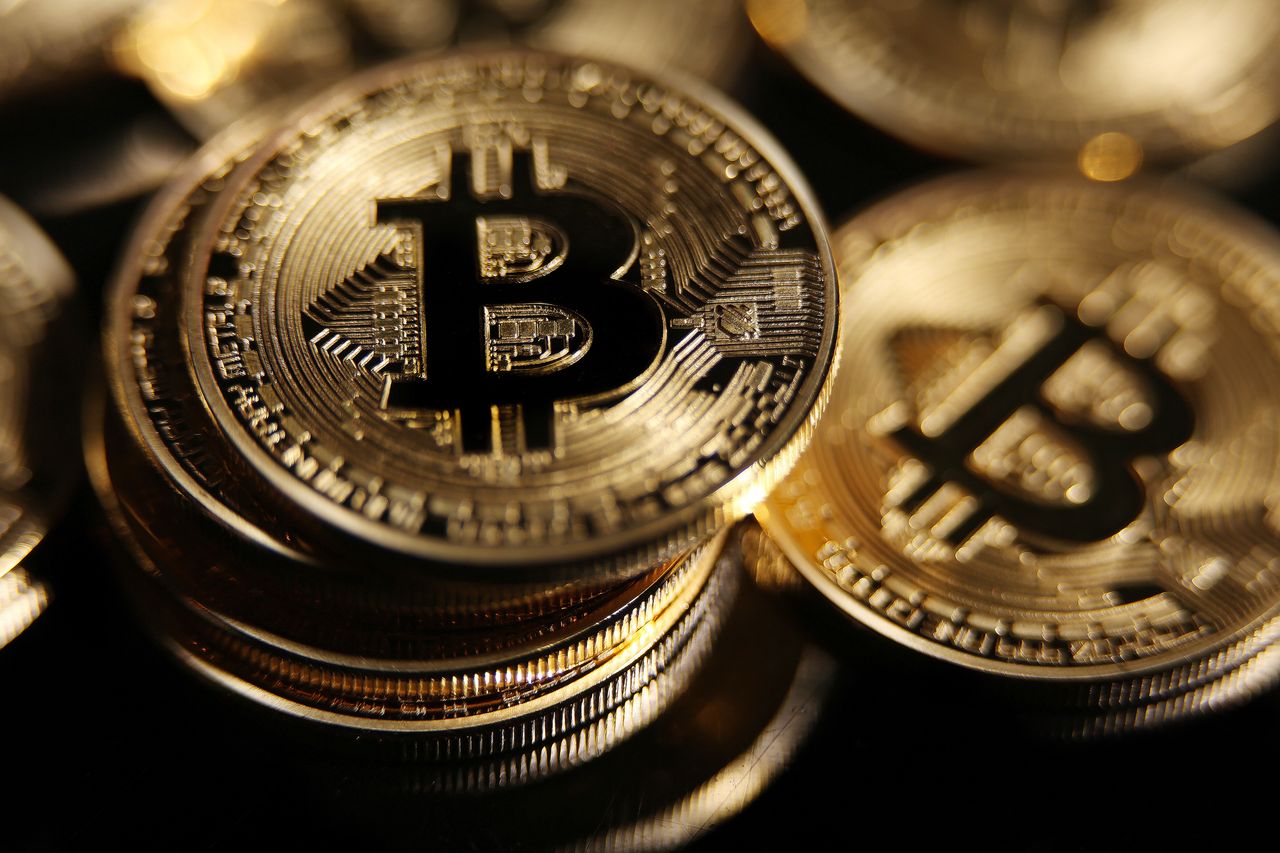GameStop Confirms Plans to Invest in Bitcoin. The Stock Is Climbing.
GameStop has approved adding Bitcoin to its balance sheet, confirming speculation as the company explores new growth avenues.
Videogame seller and meme stock GameStop said its board approved adding Bitcoin as an investment.
The company announced its board unanimously approved an update to its investment policy to add Bitcoin as a treasury reserve asset. In a filing, it said “a portion of our cash or future debt and equity issuances may be invested in Bitcoin” and that it had not set a maximum on the amount of Bitcoin it could accumulate or sell. The move had been the subject of recent speculation as GameStop seeks new sources of growth.
For the fourth quarter ended Feb. 1, GameStop reported net sales of $1.28 billion, below the $1.48 billion analysts surveyed by FactSet had expected.
Adjusted earnings of 29 cents a share beat the 8 cents a share analysts expected. Net income of $131.3 million was also above the $33 million expected.
Shares were up 6% in late trading, after closing down 0.8% on Tuesday, at $25.80. Shares traded as low as $24.99 intraday, down 2.4%, the largest intraday percentage decline since March 12, according to Dow Jones Market Data.
Analysts and investors have been more interested in updates on the company’s strategic direction than its earnings results, as GameStop faces questions about the profitability of its core business. It has been closing physical stores and expanding beyond videogames amid the continuing shift to digital gaming.
The company said it completed its divestiture in Italy and the wind-down of store operations in Germany.
For the full fiscal year ended Feb. 1, GameStop reported net sales of $3.82 billion, below the $4.02 billion expected.
Net income of $131.3 million and earnings of 33 cents a share both beat analysts’ expectations.
GameStop stock has risen 64% over the past 12 months, in part because of the return of investor Keith Gill, also known as “Roaring Kitty,” who said in a YouTube livestream in June 2024 that he is still a “ believer ” in GameStop. The shares are down 19% this year through Tuesday’s close.
“Roaring Kitty’s” social media posts helped fuel the meme stock frenzy in early 2021, pushing GameStop’s stock to its record high of $86.88 on Jan. 27, 2021.
Michael Pachter, a managing director at Wedbush Securities and former CEO of Take-Two Interactive Software who specializes in the videogame sector, said the company’s recent moves into trading cards was unlikely to be the catalyst that would turn around the core business.
“It is unfathomable that they will ever turn their core business (selling games) around by offering trading cards in their stores,” he told Barron’s in an email. When GameStop announced it was getting into the collectible trading cards business last October, he noted the company’s “utter lack of competitive advantage” in the “wildly fragmented” business.
“The company has once again accelerated store closures in an attempt to save its way to prosperity, and its plans to enter the trading card business and to invest in cryptocurrency are striking in their lack of specificity,” Wedbush analysts led by Pachter wrote in a research note Monday.
They said that GameStop’s entry into trading cards and crypto followed its last two attempts at a turnaround, and that its shares “trade at a level that ignores the company’s many challenges ahead.” They called its entry into cryptocurrency “an unsubtle attempt to emulate the success of MicroStrategy , which trades at less than 2x the value of its Bitcoin holdings.” They reiterated their Underperform rating and their 12-month price target of $10.
“Far more likely, they will continue to slowly liquidate by selling off assets” and by closing stores when their leases expire, Pachter said Monday. “That leaves them with ‘profits’ on investment income from their $4.6 billion cash hoard, which they raised by virtue of their meme stock status.”
GameStop management doesn’t hold conference calls to discuss results, and because few analysts follow the company, the consensus forecast as tracked by FactSet includes just two estimates.
Based in Grapevine, Texas, the company offers games and entertainment products online and in stores in the U.S., Canada, Australia, and Europe.
Pachter noted that GameStop’s stock price, trading around 2.5 times cash, suggests investors have faith in CEO Ryan Cohen’s ability to pick investments for them.
In February, Cohen posted a photo of himself on social media with Michael Saylor, co-founder and executive chairman of MicroStrategy, the largest institutional holder of Bitcoin , apparently helping to fuel the rumors about GameStop’s own crypto ambitions.
“MicroStrategy trades as around twice the value of its Bitcoin holdings, so it remains to be seen if Ryan Cohen can find a better cryptocurrency to invest in and drive GME share to 2.6 times the value of its assets,” Pachter said.
On March 3, GameStop announced a deal with digital financial services company Zip Co. to let U.S. customers pay in installments for their online and in-store gaming purchases.
Zip U.S. CEO Joe Heck said at the time that nearly 84% of Zip’s U.S. customers shop for gaming and accessories at GameStop. “Gaming is one of Zip’s most popular categories overall, making Zip an ideal partner for helping these shoppers responsibly purchase goods and services from one of the industry’s fan-favorites and top businesses.”
 Copyright 2020, Dow Jones & Company, Inc. All Rights Reserved Worldwide. LEARN MORE
Copyright 2020, Dow Jones & Company, Inc. All Rights Reserved Worldwide. LEARN MORE
Records keep falling in 2025 as harbourfront, beachfront and blue-chip estates crowd the top of the market.
A divide has opened in the tech job market between those with artificial-intelligence skills and everyone else.
Coca-Cola, 3M lead blue-chip index higher after reporting results.
Strong earnings reports briefly helped power the Dow Jones Industrial Average above 47000 for the first time, the latest milestone in stocks’ three-year bull run. The blue-chip average pared gains to close below the mark, but still finished at a record.
With sky-high earnings expectations baked into stock prices, Wall Street has been watching this third-quarter reporting period closely. So far, Corporate America has delivered.
Heavyweights Coca-Cola , 3M and General Motors all reported results that exceeded analyst expectations before the opening bell on Tuesday. 3M shares rose 7.7% to a four-year high, leading the Dow.
GM soared 15% to the highest level since its 2010 post-bailout initial public offering after Chief Executive Mary Barra raised guidance and told analysts the automaker can’t make enough full-size SUVs to keep up with demand.
GM said it is making faster-than-expected progress reducing a multibillion-dollar tariff bill—a key topic for investors who are still laser-focused on trade tensions between the U.S. and China.
A solid start to third-quarter earnings has helped buoy investor sentiment, taking stocks back toward record highs after concerns over trade and credit quality bubbled up earlier this month.
As of last Friday, 86% of companies overshot earnings estimates, according to FactSet. Nearly one-fifth of S&P 500 companies are scheduled to give financial updates over the course of this week.
The S&P 500 was little changed Tuesday, while the Nasdaq composite dropped 0.2%. The Dow rose 0.5% to a record closing level of 46924.74. Treasury yields slipped, with the benchmark 10-year yield closing at 3.962%, its lowest reading since October 2024.
“This is a market being driven by strong fundamentals,” said Scott Helfstein , head of investment strategy at asset manager Global X. “Earnings growth is largely driving equity values.”
Elsewhere Tuesday, it was a historically ugly day for precious metals after an epic run-up switched abruptly into reverse. Gold tumbled 5.7%, its worst single-day decline since 2013. Silver fell 7.2%.
Some analysts tied the selloff in safe-haven assets like gold to optimism that the U.S. will reach a new trade deal with China, after the U.S. and Australia signed a rare-earths trade agreement on Monday. The drop followed a remarkable run of gains : Gold remains up 55% on the year and only fell to its lowest level since Oct. 10.
In company news, Warner Bros. Discovery said it is exploring a potential sale of some or all of its media holdings, which include a movie studio, HBO Max and CNN. Its shares rose 11% on the news, which could reshape the entertainment industry.
Micro-needling promises glow and firmness, but timing can make all the difference.
Records keep falling in 2025 as harbourfront, beachfront and blue-chip estates crowd the top of the market.






















